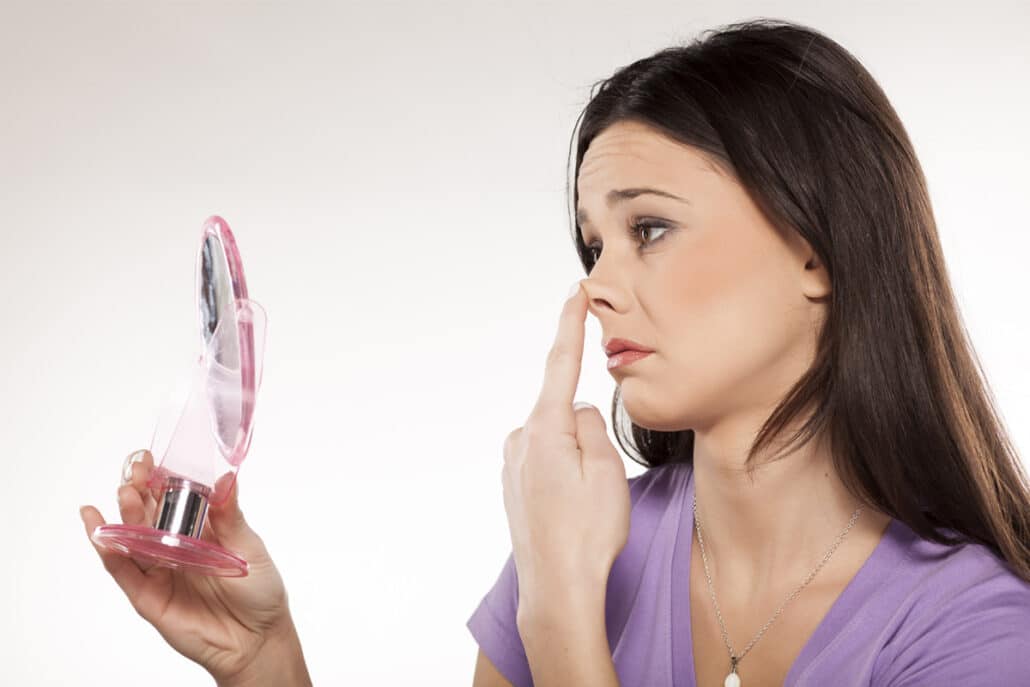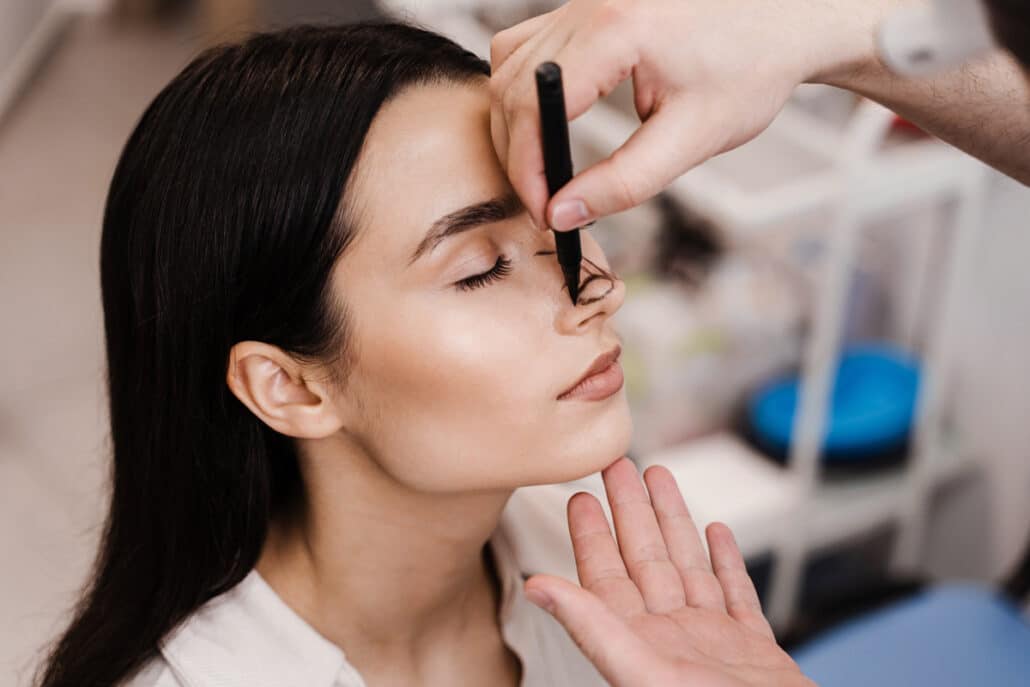Are you facing unexpected cosmetic concerns after your rhinoplasty? A ‘piggy nose’—an overly upturned nasal tip—can be a distressing aftermath of nasal surgery. The intricacies of facial harmony and self-confidence intertwined with such outcomes demand expert intervention.
Dr. Nicole Schrader, a skilled surgeon, understands the complexity of these issues and offers an array of effective procedures. Her proficiency ensures tailored strategies for individuals grappling with post-operative dissatisfaction, aiming to restore both aesthetic appeal and personal-self-assurance.

Recognize the Signs of a ‘Piggy Nose’
Identifying an upturned nose or pig nose is key to ensuring the overall harmony of facial features. This nasal structure may present distinct characteristics that differentiate it from the intended post-operative outcome. When we refer to an upturned nose, we look for a nasal tip that tilts upward excessively, disrupting the natural contour of the nose.
To properly assess this condition, observe the angle between the upper lip and the nasal tip. In a balanced configuration, this angle should not be overly pronounced. However, if the nose appears overly rotated, making the nostrils more visible from a frontal view, it might indicate an upturned nasal tip. It’s essential to monitor changes in your nose as it heals to catch any disproportionate shifts in the nasal structure.
Other aspects to watch for include:
- A shortened nasal bridge that can give the appearance of a ‘piggy nose.’
- Disproportion between the tip and the rest of the nose, resulting in an unbalanced look.
- Any disturbances in nasal function due to the altered shape and nostril size.
By being vigilant of these signs, you can address any concerns promptly with your surgeon. Remember that subtle changes to the nasal structure can significantly impact overall facial features and aesthetics.
Consult with Your Original Surgeon
After considering a revision rhinoplasty, the next vital step is to consult with the surgeon who performed your previous rhinoplasty. The surgeon, familiar with your medical history and the specifics of your first surgery, is your best resource for accurate advice. This professional can evaluate the healing process and determine whether your concerns stem from the natural settling of tissues or if genuine structural adjustments are necessary.
During the consultation, engage openly about your expectations and listen to the professional opinion of your surgeon. They can offer unique insights into the complexities of performing a secondary surgery, taking into account the changes made during the original procedure. Remember that the aim is to ensure your health and satisfaction, so trust in the experience your original surgeon brings to the table.
Wait for Full Recovery Before Making Judgments
After undergoing rhinoplasty procedures, it’s paramount to let the body heal entirely before evaluating the results. The average time of the recovery process spans several months, during which residual swelling gradually subsides. It’s crucial to remain patient and refrain from drawing any premature conclusions about the final appearance of your nose.
In the initial weeks, notable changes occur but residual swelling can still distort the true outcome. As you progress through the recovery phase, swelling disappears and the nasal contour sharpens. Here’s why waiting is essential:
- Residual Swelling: This can mask the nuances of the surgery, making the nose appear different from the expected result. Only when the swelling has fully diminished can you appreciate the final nose shape.
- Months of Patience: The body heals at its own pace, requiring months to adapt to the changes made during surgery. This period allows for any minor concerns to be addressed.
- Stress and Anxiety: Premature judgments can cause unnecessary stress. Giving yourself time ensures a more accurate assessment.
Explore Non-Surgical Solutions
Investigating non-surgical nose job techniques offers a variety of benefits for individuals looking to enhance their nasal aesthetics without the downtime and risks associated with surgery. One popular method involves the use of dermal fillers, which can alter the shape of the nose by adding volume to specific areas. This minimally invasive approach can help balance facial features with immediate results.
Non-surgical treatments should be administered by a skilled practitioner who understands the anatomy of the nasal valve, the area responsible for regulating airflow. Proper technique ensures that while the shape of the nose may be altered for cosmetic reasons, the essential function of breathing is preserved and not compromised.
Patients may explore the following alternatives:
- Dermal filler injections to smooth out bumps
- Botox to address drooping nasal tips
- Non-surgical nasal contours
Each method is designed to be temporary but offers a chance to test-drive nasal changes before committing to permanent surgical options.
Consider Revision Rhinoplasty
When an initial nose job results in a piggy nose, patients may contemplate a second rhinoplasty. This cosmetic procedure is dedicated to correcting the over-rotated, upturned appearance that characterizes a piggy nose. Surgical techniques are pivotal in addressing these aesthetic concerns, ensuring precision and effectiveness. Choosing to undergo revision nose jobs involves several criteria:
- Persistent dissatisfaction with nasal shape after initial surgery.
- Functional issues impacting breathing or nasal structure, including breathing difficulties that might arise post-operation.
- Confirmation that the nose has fully healed from the first surgery, where the integration of cartilage grafts could be considered for structural support and refinement.
An experienced surgeon evaluates these factors to ensure the viability of revision surgeries. Preferably, patients should wait at least a year for the nose to stabilize from the previous procedure. Revision surgeries are delicate; hence, selecting a surgeon who specializes in revision rhinoplasty maximizes the potential for a successful outcome. This step considers both aesthetic refinement and the correction of any functional impediments caused by the initial operation.

Prepare for a Second Surgery
When considering a revision procedure after a bad rhinoplasty procedure, patients must work closely with their surgeon to develop a comprehensive surgical plan. It’s essential to have clear communication about your desired outcomes and to understand the potential risks and benefits of undergoing a secondary surgical procedure. Preparing mentally and physically for the revision is also important, which may include:
- Ensuring good overall health for better recovery
- Following pre-surgery instructions given by your surgeon
- Planning for adequate time off work and support during recovery
These steps are crucial to set the foundation for a successful outcome of a New Jersey nose job.
Follow Post-Revision Rhinoplasty Care Instructions
Proper care of nasal skin and tissues is pivotal during the recovery period following a revision rhinoplasty. To prevent complications and support the healing process, adhere to these care instructions meticulously. Keep the nasal skin clean and moisturized, but be gentle to avoid irritation. Use prescribed ointments judiciously to aid in healing and reduce scarring.
Swelling and bruising are common in the nasal tissues; manage this with cold compresses and keeping your head elevated, especially when sleeping. Protect your nose from potential injury by avoiding glasses that rest on the nasal bridge, contact sports, or any activity that might result in a bump to the nose.
Your surgeon will provide a detailed plan tailored to the specifics of your revision surgery. It is critical to follow this guidance closely to secure the best possible outcome and to ensure that the newly revised structures settle into place. Remember, each instruction plays a role in the collective care necessary for successful recovery.
Precautions to Take When Correcting a ‘Piggy Nose’
Correcting a ‘piggy nose’ after primary rhinoplasty requires diligent planning and choosing the right surgeon for revision surgery. To ensure the safety and optimal outcome, patients must consider several safety measures.
First, select a board-certified surgeon with vast experience in correcting over-rotated noses. Their expertise offers insight into the unique challenges of secondary rhinoplasty and can mitigate potential complications. Discuss your concerns transparently, covering all previous procedures and desired corrections to your nose bridge.
Also, have realistic expectations about the results. Adjusting a pig nose may involve complex restructuring and patients need to understand that perfection is not always achievable.
Pre-surgery, conduct thorough diagnostics, including imaging, to help your surgeon plan the precise adjustments. Furthermore, adhere strictly to pre-and post-operative instructions.
Consult with a facial plastic surgery expert
Considering the importance of expertise in achieving a beautiful and natural-looking nose, especially after a bad nose job, it’s wise to consult with Dr. Nicole Schrader. As a double-board-certified facial plastic surgeon, she offers upturned nose rhinoplasty New Jersey, tailoring her approach to meet your unique needs aesthetic goal, and potential breathing concerns. Schedule your consultation today to explore the best path to your ideal facial balance.
